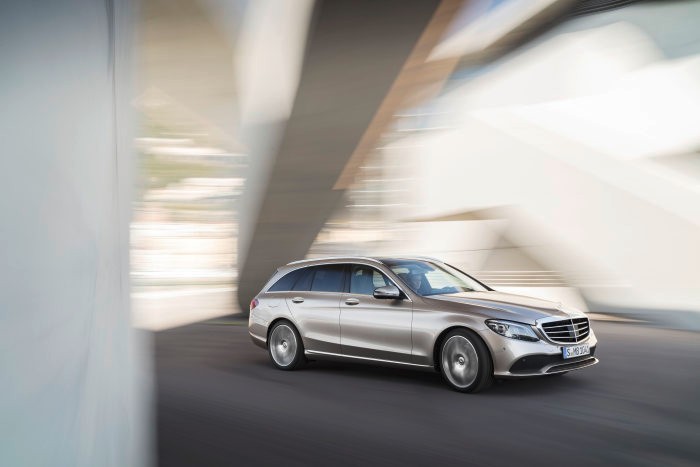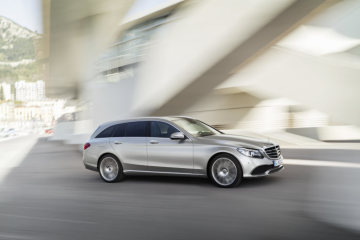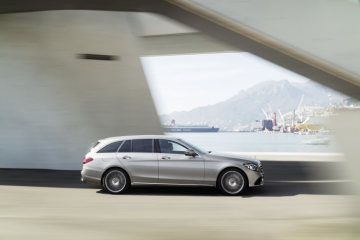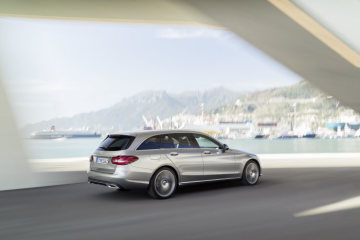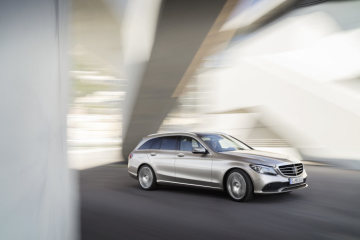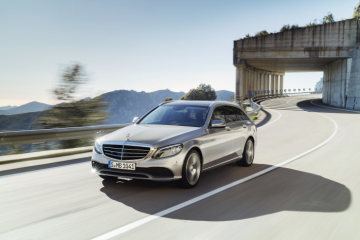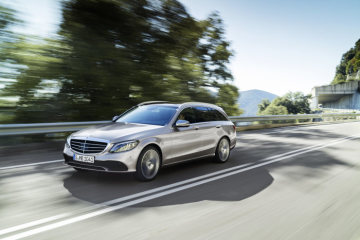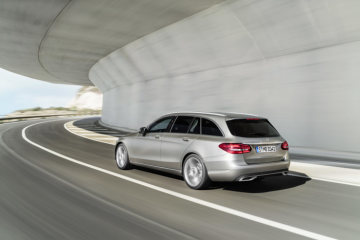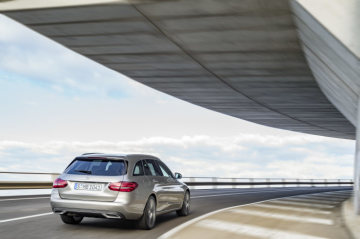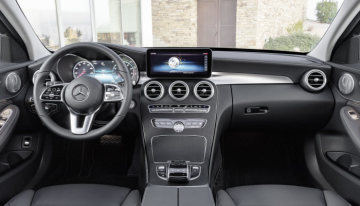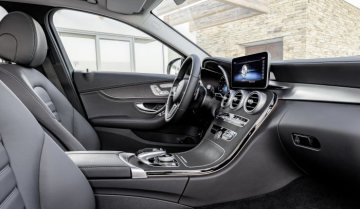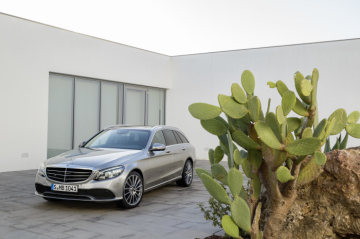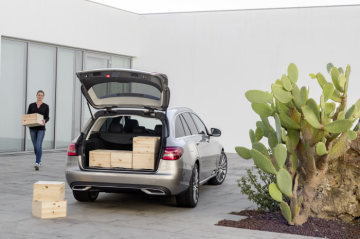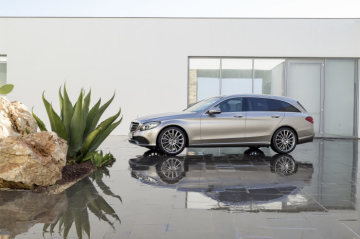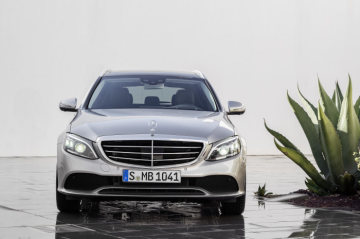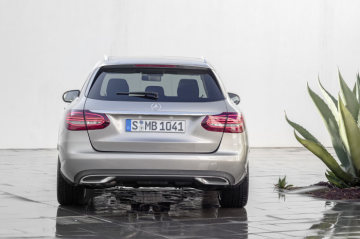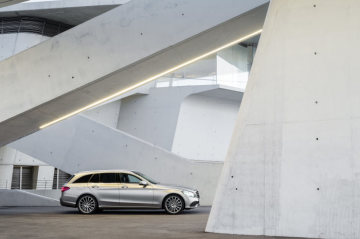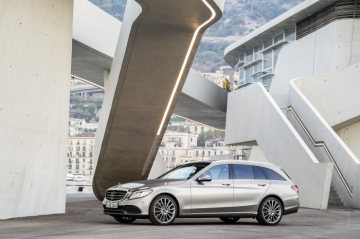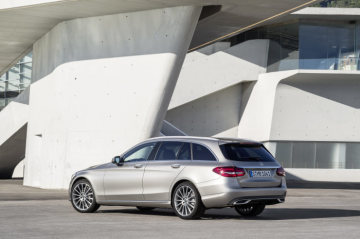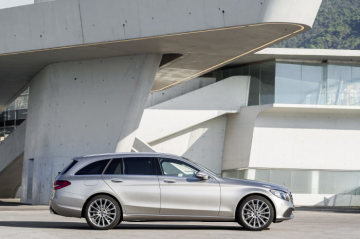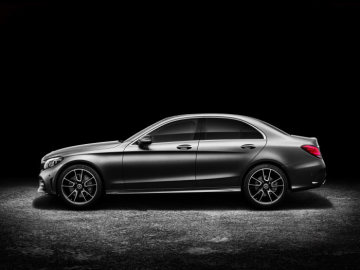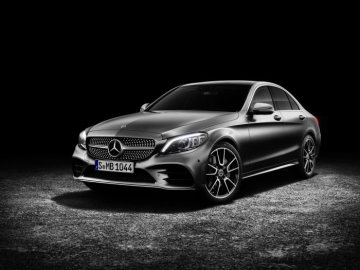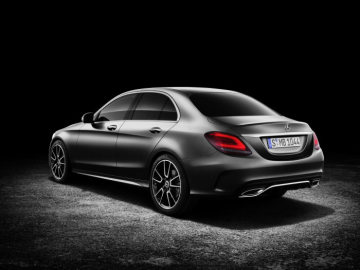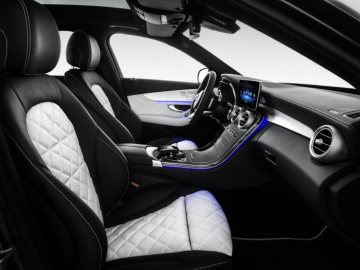
06.
March 2018
Stuttgart
Press Contact for this Press Release (2)
-
Steffen Schierholz
- Manager Communications C-Class, E-Class, CLS
- steffen.schierholz@daimler.com
- Tel: +49 711 17-75852
- Fax: +49 711 17-98646
-
Koert Groeneveld
- Head of International Product & Technology Communications
- koert.groeneveld@daimler.com
- Tel: +49 711 17-92311
- Fax: +49 711 17-94365
Fuel consumption combined: 9.4 – 4.6 l/100 km; Combined CO2 emissions: 214 – 123 g/km*
Stuttgart. The most successful model series from Mercedes-Benz is entering its fifth year in production with extensive modifications. The design of the exterior and interior benefits from a stylish makeover. The electronic architecture is completely new. The customer benefits from a user experience with an optionally fully digital instrument display and multimedia systems with tailor-made information and music. The assistance systems are now at the level of the S‑Class. The new C-Class will have its world premiere at the Geneva International Motor Show (6 to 18 March) and deliveries to sales partners will begin in June.
The C-Class in its current generation was Mercedes-Benz's top-selling model in its fourth year on sale. More than 415,000 units of the Saloon and Estate were sold worldwide in 2017. The C‑C lass is produced at four plants on four continents. These are the lead plant in Bremen (Germany) plus East London (South Africa), Tuscaloosa (USA) and Beijing (China). The Beijing plant also produces the long version of the C‑Class Saloon, which is built and sold exclusively in China. China was the biggest market for the C‑C lass in 2017.
Power and efficiency: Completely new range of engines
The C-Class Saloon and Estate will enter the market with completely new engines. The following models are e.g. available on market launch in July, with further engine variants to follow:
|
C 200 |
C 200 4MATIC |
C 220 d |
C 43 4MATIC |
|
|
Transmission |
9G-TRONIC |
9G-TRONIC |
9G-TRONIC |
AMG SPEEDSHIFT TCT 9G |
|
Cylinders/arrangement |
4/in-line |
4/in-line |
4/in-line |
6/V |
|
Displacement (cc) |
1497 |
1497 |
1951 |
2996 |
|
Output (kW/hp) Combustion engine |
135/184 |
135/184 |
143/194 |
287/390 |
|
at rpm |
5800-6100 |
5800-6100 |
3800 |
6100 |
|
Output of electric motor (kW) Recuperation Boost |
12 10 |
12 10 |
– |
– |
|
Max. torque Combustion engine (Nm) |
280 |
280 |
400 |
520 |
|
at rpm |
3.000-4.000 |
3.000-4.000 |
1.600-2.800 |
2.500-5.000 |
|
Max. torque Electric motor (Nm) |
160 |
160 |
– |
– |
|
Fuel consumption, NEDC 2.0 (l/100 km) |
6,0 (6,2)[1] |
6,5 (6,7)1 |
4,4 (4,6)1 |
9,1 (9,4)* |
|
Combined CO2 emissions (g/km), NEDC 2.0 |
136 (142)1 |
148 (153)1 |
117 (123)1 |
209 (214)* |
|
Acceleration 0-100 km/h (s) |
7,7 (7,9) |
8.1 |
6,9 (7,0) |
4,7 (4,8) |
|
Top speed (km/h) |
239 (235) |
234 |
240 (233) |
250** |
Figures in brackets: Estate; *provisional figures, **electronically limited
Electrification continues: C 200 with EQ Boost
A new generation of four-cylinder petrol engines is being launched in the new C-Class. At the same time these models are equipped with an additional 48 volt onboard network with a belt-driven starter/alternator (EQ Boost). The new petrol model will be launched as the C 200 and C 200 4MATIC with a displacement of 1.5 litres, with a 2.0-litre variant to follow later.
The combination of a 48 volt onboard network and EQ Boost creates the conditions for additional functions that help to reduce fuel consumption even further, while improving agility and comfort characteristics. When accelerating, EQ Boost can assist the 135 kW (184 hp) engine with an additional 10 kW (14 hp), bridging the brief moment until the turbocharger has built up its full charge pressure. This boosting is also used to reach the engine's ideal rpm as quickly as possible during gearshifts. The shift time of the automatic transmission is shortened as a result. During deceleration, the starter/alternator recuperates kinetic energy and charges the battery. The water pump is electrically driven and actuated by a characteristic map. This optimally adapts the cooling output to the current need.
Other advantages include gliding mode with the engine switched off, and the recuperative brake with intelligent engine stop when the vehicle is coasting: recuperation only begins with overrun cut-off when braking. When the speed falls below a certain minimum level, the powertrain is decoupled and the engine is switched off. This has the advantage of maximum fuel savings through recuperation together with comfortable vehicle response. The start/stop system operates particularly comfortably thanks to the belt-driven starter/alternator, as the engine restarts almost silently, with low vibrations and very rapidly.
The exhaust gas turbocharger uses a twin-scroll system. Thanks to its dual-flow configuration (the exhaust ducts fed by two cylinders each are separate from each other and only come together directly before the turbine), the torque characteristics have been improved while keeping the exhaust back pressure low. The charge pressure is electronically controlled, which makes it possible to set the optimum charge pressure more rapidly and precisely compared to purely pneumatic control.
CAMTRONIC variable valve timing is also on board. This allows two-stage adjustment of the valve lift on the intake side. In the partial load range this allows a smaller valve lift so that less air is fed to the combustion chamber, thereby avoiding high gas cycle losses. In higher load ranges the system switches to the higher valve lift to achieve the engine's full power delivery. The well-proven BlueDIRECT combustion process and an improved combustion chamber help to ensure low exhaust emissions. In-engine measures to reduce friction round off the efficiency strategy of the new four-cylinder power unit. These include the Mercedes-Benz patented CONICSHAPE® process, known in-house as conical honing: When form-honing the cylinder walls, the cylinder wall is opened out slightly towards the bottom, so as to reduce friction at the piston skirt for lower wear and fuel consumption. Alongside the diesel engines, all the petrol engines are also equipped with a particulate filter in Europe.
Future outlook: Plug-in diesel hybrid in the C-Class
For the first time, Mercedes-Benz is uniting an externally chargeable hybrid system with a diesel engine. At the same time, the combination of the new four-cylinder OM 654 diesel engine and the latest-generation 9G-TRONIC 9-speed hybrid transmission is a special technological highlight. 90 kW of electrical output, an additional electrical torque of 440 Nm and an intended electric range of around 50 km (NEDC) will enhance the experience of locally emission-free mobility.
The planned plug-in diesel hybrid is based on the third generation of the plug‑in hybrids that had their debut at the 2017 IAA in the S-Class S 560 e (combined fuel consumption 2.1 l/100 km, combined CO2 emissions 49 g/km, combined electrical consumption 15.5 kWh/100 km[2]). This has a new lithium-ion battery with a capacity of 13.5 kWh. The new onboard charger increases the charging capacity from 3.6 kW to 7.2 kW, which means that the battery is fully recharged at a wallbox after approx. two hours. This should be possible within seven hours even at a domestic power socket.
The third-generation hybrid technology will support the driver with further improved, intelligent drive management. Through the extended use of data from the navigation system and information from the camera and the radar sensor, the third hybrid generation looks ahead and adapts itself to the speed and route profile. Events such as negotiating towns on the way to the destination are taken into account when planning the available electrical energy, and during recuperation and thermal conditioning of the drive components.
Apart from a serene driving experience, the hybrid technology will ensure extra comfort. This is because in addition to the drive compoinents, the high-voltage onboard electrical system also supplies the electric refrigerant compressor and the high-voltage heater booster. Both will allow pre-entry climate control of the interior not only in summer but also in winter.
State-of-the-art diesel: C 220 d
The new C 220 d shares the four-cylinder diesel engine with the planned plug‑in diesel hybrid. This ultra-modern engine family opens up new dimensions in efficiency. It is the first passenger car diesel engine to use the stepped-bowl combustion process – named after the shape of the combustion bowl in the piston. The innovations also include the combination of an aluminium engine block and steel pistons, as well as the further-improved NANOSLIDE® coating of the cylinder walls.
Despite having a lower displacement than its predecessor, reduced to just under two litres, and weighing around 16 percent less, the new diesel powerplant in the C 220 d has an output of 143 kW (194 hp), precisely 18 kW more than the previous engine, and delivers an NEDC combined consumption of 4.4 (Estate: 4.6) litres per 100 kilometres. This is equivalent to CO2 emissions of 117 (123) grams per kilometre. Alongside optimised airflow on the intake and exhaust sides and the use of fourth-generation common-rail injection with pressures up to 2050 bar, the fuel saving is due to a reduction in internal friction by around 25 percent. On top of this, the engine is also more compact than its predecessor. All components relevant for efficient emissions reduction are installed directly on the engine. Thanks to the near-engine configuration, exhaust aftertreatment has low thermal losses and optimal operating conditions.
Mercedes-AMG: More performance for the C 43
The biturbo engine of the Mercedes-AMG C 43 excels with a powerful output together with low consumption and emissions. Installed close to the engine, the two turbochargers are especially spontaneous in their response.
For the new C-Class, the AMG development engineers have increased the output of the 3.0-litre V6 engine by 17 kW (23 hp) to 287 kW (390 hp). The peak torque of 520 Nm is available from 2500 to 5000 rpm. This package allows impressive performance figures: the new C 43 4MATIC Saloon accelerates from a standstill to 100 km/h in 4.7 seconds, and the Estate in 4.8 seconds. The top speed is electronically limited to 250 km/h.
The engine is combined with the AMG SPEEDSHIFT TCT 9G transmission, which the Mercedes-AMG developers have specially configured for a dynamic driving experience. This has a model-specific software application to achieve very short shift times.
4MATIC all-wheel drive: traction even in difficult road conditions
On market launch the C 200 is available with 4MATIC permanent all-wheel drive for improved traction and driving stability, especially in adverse road conditions. The 4MATIC has an active all-wheel torque distribution of 45 % to the front and 55 % to the rear. As ever, the combination of the ESP® driving dynamics control system with the 4ETS electronic traction system makes regular differential locks superfluous. This saves weight and noticeably improves handling safety as well as ride comfort.
The all-wheel drive is standard equipment for the Mercedes-AMG C 43, and features rear-biased torque distribution with a front/rear axle split of 31 to 69 percent.
The exterior: headlamps with new interior design
The new-look C-Class combines emotionality with intelligence. The vehicle's appearance is defined in particular by its front and the design of the headlamps and tail lights.
With the model facelift, the AMG line features the diamond radiator grille as standard. The front bumpers have been redesigned for all lines. These new designs render the EXCLUSIVE exterior even more expressive and lend the AVANTGARDE exterior a yet more dynamic character. The front bumper features either a silver trim strip (standard), a chrome-plated trim strip (in combination with AVANTGARDE exterior) or a three-part chrome trim strip (EXCLUSIVE exterior). In conjunction with AMG Exterior, the vehicle sports an AMG front apron with a new geometry and at the rear the insert in diffuser-look comes in a new design. The rear bumper of these models has a new lower section; geometry, trim and tailpipe trim vary according to the selected equipment and engine variant.
The design of the front and rear lamps is defined by clear-lined contours. Exquisitely crafted details add highlights and underscore the modern character. The C-Class comes with halogen headlamps incorporating LED daytime running lamps as standard. LED High Performance headlamps featuring a particularly purist interior design are optionally available. For the first time in this model series, MULTIBEAM LED headlamps with ULTRA RANGE high beam are additionally available (see below for details).
The colour spectrum has been broadened by the addition of Mojave silver metallic and emerald green metallic for Saloon and Estate.
Interior design: exquisite fine-tuning
The sporty interior exudes class, featuring flowing forms in a new interpretation of modern luxury.
The centre console is characterised by an elegant flowing trim element – optionally with new materials: open-pore brown walnut or open-pore anthracite oak. The 3D real wood veneer in the centre console combines a hand-crafted character with a modern feel. Newly available interior colours include magma grey/black, plus saddle brown for the AMG Line interior. A change of colour also applies to the option of seat belts in a special colour, which now come in magma grey instead of crystal grey.
The KEYLESS-GO starting function is standard. The start/stop button comes in a new turbine-look design. The vehicle key also features a new design. Customers have a choice between three variants here: black with high-gloss chrome surround, white with chrome surround or high-gloss white with matt chrome surround.
The Multicontour Seat package is new. With this package, the side bolsters and lumbar support can be individually adjusted by means of an electrically driven pneumatic pump. A massage effect in the lumbar area is provided by air chambers which are inflated and deflated in a pulsing or wave-like motion when the function is activated. The seat's pneumatic functions are operated via the multimedia system.
The display concept: fully digital instrument display available as an option
The C-Class has a new display concept which includes an optional, fully-digital instrument cluster with the three visually distinguishable styles "Classic", "Sport" and "Progressive".
The screen options at a glance:
Instrument cluster: The basic model features a classic two-tube instrument cluster. Between the tubes there is a 5.5-inch colour display (resolution: 383 x 600 pixels). The display style here is "Classic".
The fully digital instrument display is available as an option. The screen has a 12.3-inch diagonal and offers high resolution of 1920 x 720 pixels. The cutting-edge screen design offers the three very different display styles "Classic", "Sport" and "Progressive". The styles can be switched quickly according to personal tastes or to suit the selected interior. Alongside certain menu items such as trip data or consumption figures, the driver can now additionally view the navigation display data or the ECO display in the instrument cluster. The latter supports the driver in adopting a fuel-efficient driving style.
Central display: The multimedia screen above the centre console is also available in two sizes. In combination with Audio 20 it has a 7-inch screen diagonal and a resolution of 960 x 540 pixels. Here too, the display style is "Classic".
In combination with Audio 20, a high-resolution central display in 16:9 format is available for the first time, with a 10.25-inch screen diagonal and a resolution of 1920 x 720 pixels (standard in conjunction with COMAND and optional with Audio 20). As with the instrument cluster, a choice of three display styles is also available here. The state-of-the-art mode of presentation enables the displayed information to be grasped intuitively, with clear and informative graphics accompanying the text information under the Vehicle menu item, for example.
The C-Class has touch-sensitive controls in the steering wheel. They respond to swiping motions like the screen of a smartphone. They enable the driver to control the functions of the instrument cluster and of the entire infotainment system without having to take their hands off the steering wheel. The operation of DISTRONIC and cruise control with controls directly on the steering wheel is another new feature.
The infotainment system can additionally be operated via the touchpad with controller (new: haptic feedback) in the centre console or by means of LINGUATRONIC voice control. Vehicle functions such as the seat heating can now also be voice controlled. The optional head-up display is now adjustable over an even wider range.
Intelligent Drive: State-of-the-art active safety
The new C-Class features the latest Mercedes-Benz driving assistance systems offering the driver cooperative support, and therefore provides a higher level of active safety than its predecessor. The C-Class is able to drive semi-autonomously in certain situations. To do this it keeps a close eye on the traffic situation: improved camera and radar systems allow it to see up to 500 m ahead. The vehicle's surroundings are scanned by radar across a distance of up to 250 m to the front, 40 m to the sides and 80 m to the rear, while with the camera a range of up to 500 m is possible to the front, including 90 m in 3D.
The C-Class also uses map and navigation data for assistance functions. For example, Active Distance Control DISTRONIC as part of the Driving Assistance Package is able to give the driver map-based support in numerous situations, and predictively adjust the speed e.g. when approaching bends, junctions or roundabouts. Other new developments include intuitively understandable Active Lane Change Assist and Active Emergency Stop Assist as new functions of Active Steering Assist.
The new C-Class comes with extended Active Brake Assist as standard. Depending on the situation, this can help to mitigate the consequences of rear-end collisions with slow-moving, stopping or stationary vehicles ahead, and even with crossing pedestrians and cyclists, or prevent them altogether.
MULTIBEAM LED headlamps: Optimum visibility in all conditions
The optionally available MULTIBEAM LED headlamps are new to the C-Class. Each headlamp incorporates 84 individually controllable LEDs. These allow extremely quick and precise, electronically controlled adjustment of the headlamps to suit the current traffic situation.
New functions in comparison to the previously available LED Intelligent Light System are junction light, roundabout light, city light and bad-weather light.
In high-beam mode, Adaptive Highbeam Assist Plus enables continuous long-range illumination of the road ahead without dazzling oncoming traffic. When no other road user is detected, the road ahead is straight and the vehicle speed is above 40 km/h, ULTRA RANGE high beam is switched on automatically. This produces the maximum light intensity permitted by law, which results in the brightness of the main beam headlamps only falling below the reference value of 1 lux after a distance of more than 650 metres. When there are oncoming vehicles or vehicles ahead, the LEDs of the main beam modules are partially switched off, masking out a U-shaped area of the light beam. The other areas of the road continue to be illuminated with the high beam (partial high beam). The ULTRA RANGE high beams are only always active if high beam mode has been manually switched on.
ENERGIZING comfort control: for enhanced well-being
ENERGIZING comfort control (optional) links various comfort systems in the vehicle. It systematically uses the functions of the climate control system (including fragrancing) and the seats (heater, ventilation, massage) as well as lighting and musical moods, and enables a specific wellness set-up tailored to the mood and need of the customer. This has positive effects on wellbeing and driver performance.
Depending on the equipment level, up to six programmes are available (Freshness, Vitality, Warmth, Cosiness, Joy, Training). The programmes all run for ten minutes. They are visualised in the central display with colour graphics, and backed by suitable music. Five songs are already stored in the programme. The key function in the "Vitality" program, for example, is fast music with many beats per minute. If personal music selections are available, e.g. via the Media Interface, the system analyses them in the background and assigns them to a programme based on the beats per minute (bpm). Individual functions of the programmes can be deactivated.
ENERGIZING comfort control also incorporates ambience lighting, which is harmoniously tailored to each of the individual screen designs. With 64 colours, the optional extended ambience lighting offers a wealth of individual settings.
The multimedia systems: Tailor-made information and music offerings
The C-Class comes as standard with the Audio 20 multimedia system featuring two USB ports, an SD card reader, Bluetooth connection and media interface.
The latest-generation COMAND Online available as optional equipment offers fast 3D hard-disc navigation with topographical map display, photo-realistic 3D buildings and 3D map rotations. Comprehensive information is displayed on the navigation map: in addition to real-time traffic density information it can e.g. include Car-to-X warning messages, the weather, filling stations including current fuel prices and free parking spaces.
With the Concierge service (available as a subscription service), Mercedes me connect customers have a host of individual services at their disposal: from making restaurant reservations and obtaining tips about tourist routes, to gathering information on cultural or sporting events and sending navigation destinations directly to the vehicle.
Anti-theft alarm system: also recognises parking damage and sends a message
Another new feature is the automatic notification by text message if the vehicle suffers an impact caused by another vehicle when parked, or is towed away. The highly sensitive sensors of the optional "Anti-theft alarm system (ATA)" can detect such situations and immediately send a "push notification" message to the Mercedes me App. As soon as the customer starts the vehicle again, he/she is also informed by a corresponding message in display of the COMAND Online multimedia system. In the Mercedes me App and in the COMAND Online display, the customer is also shown when (at what time) and where (e.g. front left) the impact occurred. This optional equipment includes the new sensors and the corresponding software; the service will go live in the second quarter of 2018.
Mobility with the digital key: The C-Class uses NFC technology
The optional digital vehicle key uses Near Field Communication (NFC) to turn the customer's smartphone into a vehicle key. However, not every smartphone has an NFC interface that complies with Mercedes-Benz security standards. For the new C-Class, and initially in Germany, there is a special digital vehicle key sticker with a built-in microcontroller. Customers can order this sticker from the Mercedes me portal. Delivery is through a Mercedes-Benz sales partner.
With the digital vehicle key sticker, the vehicle can be unlocked, locked and started remotely. To start the engine, the driver simply needs to place the smartphone with the sticker in the centre console stowage tray. Mobile devices corresponding to the Qi standard can be charged conveniently while on the move with the optional wireless charging system. The charging surface in the quick stowage tray at the front of the centre console is also suitable for large smartphones. This function also includes multifunction telephony, which additionally pairs the smartphone with the vehicle's exterior aerial. This equips the vehicle for the best possible telephone connections and data transfer.
An additional sound system is now optionally available. With nine speakers and an output of 225 W (2 x Frontbass with 50 W, remaining five channels each with 25 W), it is positioned between the standard sound system and the Burmester® surround sound system.
[1] The stated figures were determined in accordance with the prescribed measuring method. These are the "NEDC CO2 figures“ according to Art. 2 No. 1 Implementing Regulation (EU) 2017/1153. The fuel consumption figures were calculated based on these figures.
[2] The figures shown are the "measured NEDC CO2 values" acc. to Art. 2 No. 2 Implementing Order (EU) 2017/1153, determined in accordance with Appendix XII of Directive (EC) No. 692/2008. The fuel consumption figures were calculated on the basis of these figures. The electrical consumption was determined on the basis of Directive 692/2008/EC. Owing to legislative changes to the test procedures concerned, higher values may have been entered in the vehicle's compliance certificate required for vehicle registration and possibly road tax assessment.
Download
Filter
Show thumbnails
Show list
Slideshow

Do you really want to delete the data record?
Please wait a moment …
Please wait a moment …
Please wait a moment …
Please wait a moment …
-
17C898_006
-
17C898_008
-
17C898_011
-
17C898_013
-
17C898_022
-
17C898_023
-
17C898_048
-
17C898_054
-
17C898_066
-
17C898_068
-
17C898_069
-
17C898_073
-
17C898_081
-
17C898_086
-
17C898_087
-
17C898_091
-
17C898_099
-
17C898_106
-
17C898_120
-
18C0130_02
-
18C0130_03
-
18C0130_04
-
18C0130_01

LoadingOriginal Article
